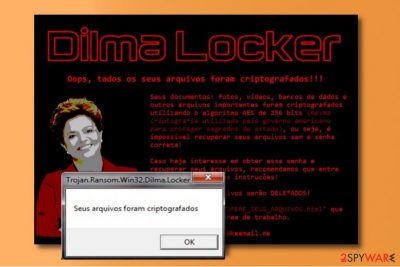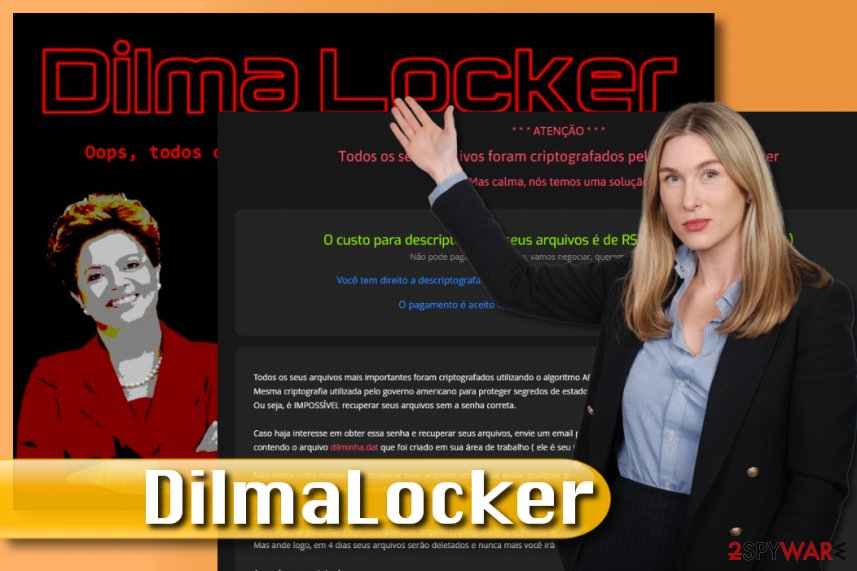DilmaLocker ransomware / virus (Removal Guide) - Decryption Methods Included
DilmaLocker virus Removal Guide
What is DilmaLocker ransomware virus?
DilmaLocker is yet another virtual extortion tool set to encrypt your files

DilmaLocker is a new ransomware-type virus that compromises victim’s files to demand a ransom[1]. The malicious software employs AES-256 cipher to encode all user’s files and leaves a ransom note called RECUPERE_SEUS_ARQUIVOS.html and dilminha.dat. When encrypting the data, ransomware appends .__dilmaV1 file extension to each file.
The malicious virus triggers a pop-up message saying “Seus arquivos foram criptografados,” which roughly translates from Portuguese to “Your files were encrypted.” The virus presents itself as Trojan.Ransom.Win32.Dilma.Locker. The virus also changes the background image that suggests writing to dilmaonion@keemail.me to get data recovery instructions. Dilma virus also informs the victim that all files on the system will be deleted after four days.
DilmaLocker authors demand to pay 3000 Brazilian Reals in Bitcoin. The sum is equal to 968 US dollars. However, the criminals admit that they are ready for negotiations if the user cannot afford to pay a ransom of nearly thousand USD.
In addition, cyber criminals suggest to prove their intentions and say that they can decrypt one file of victim’s choice. The only condition is that the file cannot be larger than 3MB in size.
However, we do not recommend paying the ransom because you get no guarantees that your files will be decrypted. The criminals can disappear at any moment and leave you with piles of encrypted data. Therefore, if your computer got hit by ransomware, we recommend you to remove DilmaLocker virus immediately. You should consider using a good anti-malware software such as FortectIntego to eliminate it.

However, it is not that easy to remove a ransomware virus. For a successful DilmaLocker removal, you might need to use instructions provided below this article to reboot your PC into Safe Mode with Networking. This helps to deactivate the virus (temporarily) to delete it without any interruptions.
Distribution of Dilma virus
It is suspected that DilmaLocker spreads via malicious spam and possibly RDP attacks. However, it is unknown whether the virus uses more sophisticated distribution methods such as malvertising[2] or exploit kits. According to Udenvirus.dk team[3], to prevent the ransomware from infecting your PC and taking your files hostage, you simply need to:
- Install a reliable security software;
- Create a data backup;
- Enable automatic software updates or just install software updates manually (and regularly!);
- Avoid opening suspicious emails or clicking on questionable ads or links when browsing the Internet.
Remove DilmaLocker virus for good
You can remove DilmaLocker quite easily. All that you need to do is to restart your PC using the given instructions, and allow your security software run. Keep in mind that a system reboot into a Safe Mode with Networking is required in order to eliminate the virus without facing any possible obstacles.
Do not delay DilmaLocker removal and clean your computer now. Remember – paying the ransom is not the solution to the problem and this option might not help to recover your data. Instead of paying the extortionists, consider trying one of the provided data recovery methods (see instructions below).
Getting rid of DilmaLocker virus. Follow these steps
Manual removal using Safe Mode
Uninstall Dilma Locker ransomware using the given tutorial:
Important! →
Manual removal guide might be too complicated for regular computer users. It requires advanced IT knowledge to be performed correctly (if vital system files are removed or damaged, it might result in full Windows compromise), and it also might take hours to complete. Therefore, we highly advise using the automatic method provided above instead.
Step 1. Access Safe Mode with Networking
Manual malware removal should be best performed in the Safe Mode environment.
Windows 7 / Vista / XP
- Click Start > Shutdown > Restart > OK.
- When your computer becomes active, start pressing F8 button (if that does not work, try F2, F12, Del, etc. – it all depends on your motherboard model) multiple times until you see the Advanced Boot Options window.
- Select Safe Mode with Networking from the list.

Windows 10 / Windows 8
- Right-click on Start button and select Settings.

- Scroll down to pick Update & Security.

- On the left side of the window, pick Recovery.
- Now scroll down to find Advanced Startup section.
- Click Restart now.

- Select Troubleshoot.

- Go to Advanced options.

- Select Startup Settings.

- Press Restart.
- Now press 5 or click 5) Enable Safe Mode with Networking.

Step 2. Shut down suspicious processes
Windows Task Manager is a useful tool that shows all the processes running in the background. If malware is running a process, you need to shut it down:
- Press Ctrl + Shift + Esc on your keyboard to open Windows Task Manager.
- Click on More details.

- Scroll down to Background processes section, and look for anything suspicious.
- Right-click and select Open file location.

- Go back to the process, right-click and pick End Task.

- Delete the contents of the malicious folder.
Step 3. Check program Startup
- Press Ctrl + Shift + Esc on your keyboard to open Windows Task Manager.
- Go to Startup tab.
- Right-click on the suspicious program and pick Disable.

Step 4. Delete virus files
Malware-related files can be found in various places within your computer. Here are instructions that could help you find them:
- Type in Disk Cleanup in Windows search and press Enter.

- Select the drive you want to clean (C: is your main drive by default and is likely to be the one that has malicious files in).
- Scroll through the Files to delete list and select the following:
Temporary Internet Files
Downloads
Recycle Bin
Temporary files - Pick Clean up system files.

- You can also look for other malicious files hidden in the following folders (type these entries in Windows Search and press Enter):
%AppData%
%LocalAppData%
%ProgramData%
%WinDir%
After you are finished, reboot the PC in normal mode.
Remove DilmaLocker using System Restore
-
Step 1: Reboot your computer to Safe Mode with Command Prompt
Windows 7 / Vista / XP- Click Start → Shutdown → Restart → OK.
- When your computer becomes active, start pressing F8 multiple times until you see the Advanced Boot Options window.
-
Select Command Prompt from the list

Windows 10 / Windows 8- Press the Power button at the Windows login screen. Now press and hold Shift, which is on your keyboard, and click Restart..
- Now select Troubleshoot → Advanced options → Startup Settings and finally press Restart.
-
Once your computer becomes active, select Enable Safe Mode with Command Prompt in Startup Settings window.

-
Step 2: Restore your system files and settings
-
Once the Command Prompt window shows up, enter cd restore and click Enter.

-
Now type rstrui.exe and press Enter again..

-
When a new window shows up, click Next and select your restore point that is prior the infiltration of DilmaLocker. After doing that, click Next.


-
Now click Yes to start system restore.

-
Once the Command Prompt window shows up, enter cd restore and click Enter.
Bonus: Recover your data
Guide which is presented above is supposed to help you remove DilmaLocker from your computer. To recover your encrypted files, we recommend using a detailed guide prepared by 2-spyware.com security experts.To restore your files, you should experiment and try one of the provided methods (in case you do not have a data backup!).
If your files are encrypted by DilmaLocker, you can use several methods to restore them:
Firstly, attempt to recover files with Data Recovery Pro
Data Recovery Pro software might be the answer. It is a reliable data recovery tool and it might help you to restore lost files.
- Download Data Recovery Pro;
- Follow the steps of Data Recovery Setup and install the program on your computer;
- Launch it and scan your computer for files encrypted by DilmaLocker ransomware;
- Restore them.
Secondly, attempt to restore encrypted data with ShadowExplorer
ShadowExplorer is a software that might help you to recreate encrypted files using Volume Shadow Copies. It also checks if the virus deleted them from the system or not.
- Download Shadow Explorer (http://shadowexplorer.com/);
- Follow a Shadow Explorer Setup Wizard and install this application on your computer;
- Launch the program and go through the drop down menu on the top left corner to select the disk of your encrypted data. Check what folders are there;
- Right-click on the folder you want to restore and select “Export”. You can also select where you want it to be stored.
Finally, you should always think about the protection of crypto-ransomwares. In order to protect your computer from DilmaLocker and other ransomwares, use a reputable anti-spyware, such as FortectIntego, SpyHunter 5Combo Cleaner or Malwarebytes
How to prevent from getting ransomware
Stream videos without limitations, no matter where you are
There are multiple parties that could find out almost anything about you by checking your online activity. While this is highly unlikely, advertisers and tech companies are constantly tracking you online. The first step to privacy should be a secure browser that focuses on tracker reduction to a minimum.
Even if you employ a secure browser, you will not be able to access websites that are restricted due to local government laws or other reasons. In other words, you may not be able to stream Disney+ or US-based Netflix in some countries. To bypass these restrictions, you can employ a powerful Private Internet Access VPN, which provides dedicated servers for torrenting and streaming, not slowing you down in the process.
Data backups are important – recover your lost files
Ransomware is one of the biggest threats to personal data. Once it is executed on a machine, it launches a sophisticated encryption algorithm that locks all your files, although it does not destroy them. The most common misconception is that anti-malware software can return files to their previous states. This is not true, however, and data remains locked after the malicious payload is deleted.
While regular data backups are the only secure method to recover your files after a ransomware attack, tools such as Data Recovery Pro can also be effective and restore at least some of your lost data.
- ^ Elle Hunt. Don't pay WannaCry demands, cybersecurity experts say. The Guardian - Technology. Latest Technology News, Comment and Analysis.
- ^ John Leyden. UCL ransomware attack traced to malvertising campaign. The Register. Sci/Tech News for the World.
- ^ UdenVirus. UdenVirus. Malware and Spyware News.





















